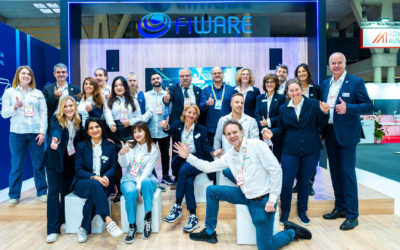On 6 May from 10:00-11:00 (CEST) Francisco Meléndez, FIWARE Foundation Technical Expert and Evangelist, will return with FIWARE’s second Wednesday Webinar on Robotics.
The FIWARE webinar series is an ongoing series that covers all that you need to learn about FIWARE, including what each of the FIWARE components brings and how apps can be developed using them. During the webinars, our FIWARE Technical Experts will also explain what the vision and value proposition of FIWARE is in specific domains such as Smart Cities, Smart Agrifood, Smart Energy, and Smart Industry and showcase the kind of initiatives members of the FIWARE Community are carrying out beyond the development of the technology.
The free webinar on 6 May will focus on how to develop FIWARE NGSI interfaces for robots. During the session, Francisco will present different alternatives to develop FIWARE-ready robots and the main FIWARE components that can facilitate and empower these developments.
The webinar will also briefly reference the enabling technologies: FIWARE interfaces for OPC-UA and ROS based robotics, Fast-RTPS (the default middleware of ROS2 environments), and micro-XRCE DDS (the middleware that supports distributed communications in micro-ROS environments). One use case based on ROS2 will be presented. In turn, the current integration of FIWARE with micro-ROS environments will be presented as a particularization of the ROS2<>FIWARE integration.
Click here to register for the upcoming webinar on “FIWARE NGSI interfaces for robots”.
FIWARE Robotics – Further Relevant Initiatives
The FIWARE Foundation has enabled and coordinated a specific working group for robotics. So far, six members of the FIWARE Foundation are playing leading roles in this working group, which defines and materializes the roadmap of the Foundation in this field. TIS, from Japan, is working on the development of a digital platform as well as on the definition of composable, smart data models for robotics systems. The Spanish eProsima leads the FIWARE activities that are connected to the ROS (Robot Operating System) ecosystem and its contributions gravitate around the Fast RTPS and Micro XRCE-DDS components of the FIWARE Catalogue. The Fraunhofer Institute for Material Flow and Logistics (Fraunhofer IML) works on providing robotics solutions to relevant problems in their domain. The contribution of Atos to this working group is focussed on research and development activities that are linked to cloud-based robotics applications. In turn, NEC and Engineering are playing a key role in advancing the FIWARE robotics developments within the Smart Industry sector.
The Robotics Working Group is open to anyone who is interested in joining, as well as participating and contributing to the evolution of the robotics roadmap. For more information, please contact Francisco Meléndez.
FIWARE Robotics is currently applied in various domains, such as Open Source robotics and Industrie 4.0 (with more domains to come), and projects, including (but not limited to) DIH2, which accelerates factories through robotics and facilitates connections that will enable agile production in factories, as well as micro-ROS, which puts ROS2 onto microcontrollers.
DIH2 consists of a network of 26 European Digital Innovation Hubs, with the objective to grow this network to 170 Digital Innovation Hubs. Within the project, 26 ‘Powered by FIWARE’ architectures will implement Agile Production Concepts in robotized manufacturing SMEs, with 13 of these pilot implementations starting in July 2020. For more information, please visit the DIH2 website.
Micro-ROS is a robotic framework targeting embedded and deep embedded robot components with extremely constrained computational resources. Here, FIWARE contributes to an Open Source Framework for robotics development. The project thereby promotes and exploits the synergies between FIWARE and ROS ecosystems and extends these ecosystems by integrating communities and technologies from the embedded and real-time systems domains. For more information, please visit the micro-ROS website.



